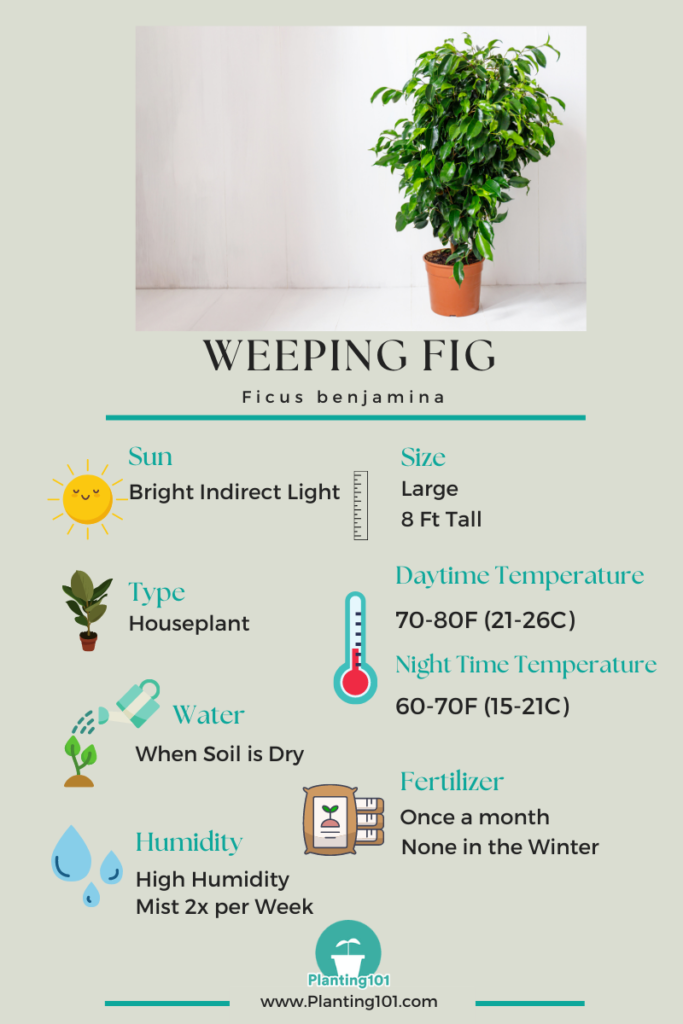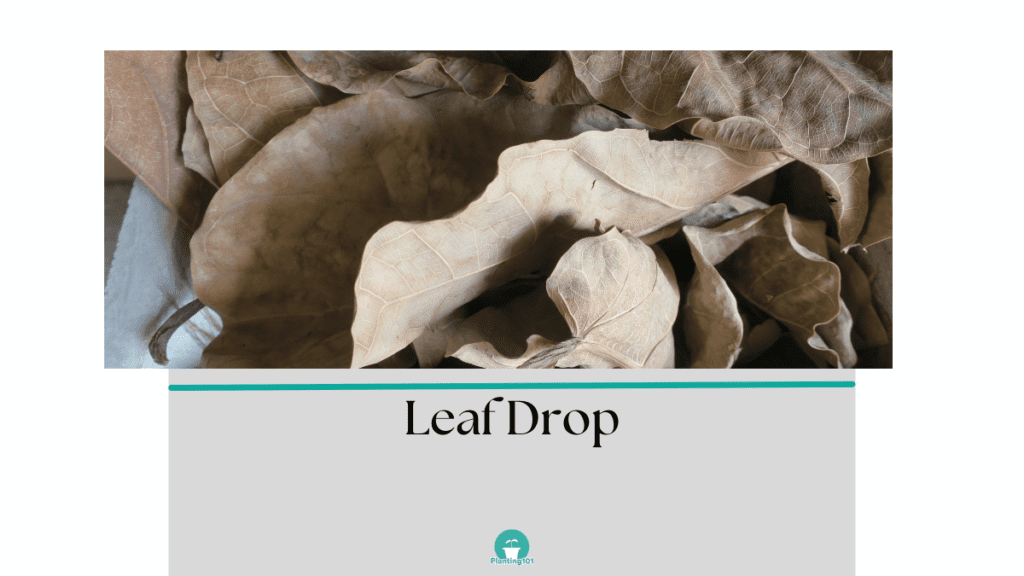The delicate foliage and graceful branches of the Weeping Fig (Ficus Benjamina) make it a favorite houseplant. It is a fast-growing plant that can reach a height of 8 feet. The weeping fig plant is also available as a bonsai. Your Weeping Fig is a low-maintenance plant when compared to its cousin Ficus lyrata (Fiddle-Leaf fig). Here are some pointers for caring for your Weeping Fig.
Weeping Fig Infographic

Weeping Fig (Ficus Benjamina) Basics
| Name | Weeping Fig |
| Scientific Name | Ficus Benjamina |
| Light | Bright Indirect Light |
| Daytime Temperature | 65 to 75 F (18-24C) |
| Night Time Temperature | 65 to 75 F (18-24C) |
| Water | Light Water |
| Humidity | High Humidity |
| Potting | Well-draining, organic, all-purpose potting soil |
| Fertilizer | Once a month but not in the Winter |
Weeping Fig: Other Names
Weeping Fig is also called Benjamin tree, Fig, Weeping Fig, Small-leaved Rubber Plant, Chinese Banyan, Ficus tree, Ficus and Fig.
Weeping Fig: Varieties
Fiscus benjamina Variegata or Starlight– Variegated leaves

Weeping Fig: Size
Weeping Fig are large plants that can grow to 8 feet tall.
Light
Weeping Fig: Sun or Shade?
Weeping Fig will grow in a bright, indirect light environment (you need to filter the light). Filtered light from a South, West, or East window will be ideal for your Weeping Fig. Use sheer shades or sheer curtains to filter the sunlight.
Once your Weeping Fig has found its happy place, it does not like to be moved. When you move your Weeping Fig, part of its leaves will fall off. But don’t panic, the leaves will regrow!
Water
How Often Should You Water Your Weeping Fig?
Weeping Fig likes soil that is neither too moist nor too dry. It requires only moderate watering. The frequency with which you water will be significantly depending on the type of pot and how dry your environment is. Allow the soil to dry halfway before watering your Weeping Fig.

How Do You Know When to Water Your Weeping Fig?
When the soil gets dry, water your Weeping Fig. The best technique to detect when it’s time to water is to stick your finger 2 inches deep into the soil. It’s time to water your Weeping Fig, if the soil feels dry.
The frequency with which you water your Weeping Fig will be determined by the sort of pot you have it in. Unglazed pots, such as terracotta, are porous and will dry out faster than Weeping Figs grown in plastic, metal, or glazed ceramic pots. Because these pots do not breathe, they will keep moisture for a much longer period of time.
The environment will also have an impact on how frequently you water your Weeping Fig. Summer days will necessitate more watering (even if your Weeping Fig is indoors), whereas winter days will necessitate less watering.
What Type of Water Should You Use When Watering Your Weeping Fig?
Weeping Fig may be watered with tap water, but be aware of the water temperature you choose. Water your Weeping Fig using lukewarm water from the faucet. The Weeping Fig prefers cool water that is neither hot nor cold.
When you turn on the cold water faucet, add a small amount of warm water. You can also get this perfect temperature by filling a watering can or pitcher with water and putting it out overnight until the water has reached room temperature.
How Do You Make Sure There is Proper Drainage for Your Weeping Fig?
Weeping Fig requires appropriate drainage or else it will suffer from stem rot. Make sure the pot has drainage holes on the bottom to ensure appropriate drainage. After watering your plant, don’t let it sit in the puddle of water that has accumulated in the saucer. Remove the water from the saucer.
Do You Need to Mist Your Weeping Fig?
Weeping fig is a tropical plant that thrives in humid environments. Here are some things you can do to raise the humidity level in your home.
- Using a spray bottle of water, mist your Weeping Fig twice a week.
- Run the humidifier to increase the indoor humidity.
- Keep Weeping Fig in a saucer of water, but raise the pot with pot feet or rocks.
Soil
What Type of Potting Mix is Best for Your Weeping Fig?
A well-draining, organic potting mix is required for Weeping Fig. You can buy potting soil that has been pre-mixed with organic fertilizers, beneficial microorganisms, and mycorrhizal fungi.
Organic soil combinations are preferable to non-organic soil mixtures because non-organic soil mixtures frequently include a higher concentration of fertilizer, which might burn the roots of your plant. Houseplants should not be grown in non-organic soil formulations.
How Do You Know When To Repot Your Weeping Fig?
Every 2-3 years, you’ll have to repot your Weeping Fig. Purchase a larger pot with a diameter of roughly 4 inches greater than the current pot. Make sure the pot has drainage holes in the bottom so water doesn’t collect and cause root and stem rot.
Stop repotting your Weeping Fig once it has reached its maximum size. To avoid tipping over, repot the Weeping Fig in a hefty pot.
Know that repotting your Weeping Fig will cause it to drop its leaves. Don’t be concerned; the leaves will regrow!
Fertilizer
Do You Need to Fertilize Your Weeping Fig?
A monthly application of fertilizer will assist the Weeping Fig. When it is vigorously growing, apply fertilizer. When it’s dormant and not growing in the winter, don’t feed it.
What Fertilizer Should You Use for Your Weeping Fig?
Use organic fertilizers with a higher ratio of nitrogen content.
Propagation
How Do You Propagate Your Weeping Fig?
Weeping Fig is simple to grow. Stem cuttings are an easy way to propagate your Weeping Fig. Choose a stem with a node (the place where a leaf was, this will grow into roots). Below the node, make a cut. Put the stem cutting in a jar of water and let it grow roots. The stem should have no more than two leaves; if there are more, simply cut them off. You can also soak a stem cutting in root hormone before planting it in moist sand.
I prefer to keep it in a jar so that you can watch the roots grow. Some Weeping Fig stem cuttings will not produce roots, while others will. Plant the stem cuttings in a new pot once the roots have grown. After planting, water thoroughly. Water every 2-3 days till the roots take hold. Place your new Weeping Fig plant in a location that receives bright indirect sunlight.
Common Problems of Weeping Fig Care
The most common problems that affect Weeping Fig are scale, leaf drop and leaf spot fungus.
Weeping Fig: Lots of Leaves Dropping
Problem: When the leaves of your Weeping Fig begin to fall, it is an indication that something is wrong. It’s normal for one or two old leaves to fall off Weeping Fig, but if a large number of leaves fall off all at once, something is wrong.

Cause: It’s possible that your Weeping Fig’s leaves are falling because it was overwatered. Moving your Weeping Fig to a new area where it is unhappy might also cause the leaves to drop. If it gets too chilly, your Weeping Fig will drop its leaves.
Solution: You’ll have to do some investigating. Did you overwater your Weeping Fig? Is the room’s daytime and overnight temperature acceptable for your Weeping Fig? Once you determine what is causing the leaves to fall from your Weeping Fig., you can address the problem.
Weeping Fig: Black and Brown Spots on Leaves
Problem: If you notice roundish black and brown patches on the leaves of your Weeping Fig, you may have leaf spot fungus infestation.

Cause: Leaf spot fungus is contagious because fungus spores can spread through the air and infect neighboring plants in the room.
Solution: When you notice these black and brown spots on the leaves of your Weeping Fig, cut off the infected leaves and discard them. To prevent future infections, spray your Weeping Fig with a DIY baking soda spray. Simply combine 1 teaspoon baking soda and 1 quart water in a spray bottle to generate the baking soda spray.
Don’t overspray because it can end up in the soil. The trick is to remove the affected leaves, which should hopefully stop the spread of the disease.
Weeping Fig: Lots of Small Brown Bumps on Leaves
Problem: Scale can be detected by the presence of small brown bumps on the leaves and stems of your Weeping Fig. Pick the lumps off; if they come off easily, this is an indicator of scale. The little lumps might also be gray, yellow, or black in color.

Cause: Scale is a common problem with houseplants that is caused by scale insects.
Solution: Scale can be removed by picking it off one by one. Alternatively, spray your Weeping Fig with insecticidal soap or horticultural oil for an easier solution.
Check out our article on how to make your own homemade pesticides using baby shampoo: How to Make Horticultural Oil and How to Make Insecticidal Soap
You May Also Be Interested in Other Ficus: How to Take Care of Your Rubber Tree at Home (Infographic) and How to Take Care of Your Fiddle Leaf Fig (Infographic)

